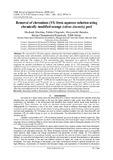Please use this identifier to cite or link to this item:
https://cris.library.msu.ac.zw//handle/11408/3298| Title: | Removal of chromium (VI) from aqueous solution using chemically modified orange (citrus cinensis) peel | Authors: | Mandina, Shadreck Chigondo, Fidelis Shumba, Munyaradzi Nyamunda, Benias Chomunorwa Sebata, Edith |
Keywords: | Adsorption isotherm Biosorption Chemical modification Chromium (VI) |
Issue Date: | 2013 | Publisher: | Hindawi Publishing Corporation | Series/Report no.: | Journal of Applied Chemistry;Vol. 6, No. 2 : p. 66-75 | Abstract: | The removal of Cr (VI) from aqueous solutions onto chemically modified orange peel was studied at varying initial metal concentrations, adsorbent doses, pH and contact times. Batch experiments were carried out under optimized conditions to evaluate the adsorption capacity of the orange peel chemically modified with sodium hydroxide. The residual Cr (VI) concentrations after biosorption were analyzed by FAAS. The biosorbent was characterized by FT-IR spectroscopy and BET. The characterization of the orange peel biomass suggested the possible contribution of carboxyl and hydroxyl groups in Cr (VI) biosorption. Chemically modified orange peel exhibited more adsorption potential as compared to the raw orange peel. The biosorption efficiency of the orange peel was dependent on the pH of the Cr (VI) solution, with pH 2 being optimal. The removal rate of Cr (VI) ions increased with increase in contact time and remained constant after an equilibrium time of 180 min. The removal of Cr (VI) ions increased with increase in biosorbent concentration with the optimal adsorbent dosage at 4.0 mg/L. The increase in initial Cr (VI) ion concentration led to an increase in the percentage removal of Cr (VI). The adsorption data fitted well with the Freundlich isotherm model with R 2 = 0.987 for the raw orange peel and R 2 = 0.995 for the modified orange peel. The Freundlich constants K f and n were 97.07 [mg/g (L/mg) n ] and 0.79 (g/L) for the raw orange peel and 139.0 [(mg/g)(L/mg) n ] and 0.815 (g/L) for modified orange peel respectively. The present study revealed that orange peel which is a low cost agricultural material could be used as an efficient sorbent for the removal of Cr(VI) from aqueous solutions and that chemical modification of the biosorbent using sodium hydroxide enhanced adsorption capacity. | URI: | https://pdfs.semanticscholar.org/071c/e106105e9e9398841c22e39f87fbd31a51f9.pdf http://hdl.handle.net/11408/3298 |
ISSN: | 2356-7171 |
| Appears in Collections: | Research Papers |
Files in This Item:
| File | Description | Size | Format | |
|---|---|---|---|---|
| Removal of chromium.pdf | Full Text | 936.05 kB | Adobe PDF |  View/Open |
Page view(s)
112
checked on Apr 20, 2025
Download(s)
20
checked on Apr 20, 2025
Google ScholarTM
Check
Items in MSUIR are protected by copyright, with all rights reserved, unless otherwise indicated.



